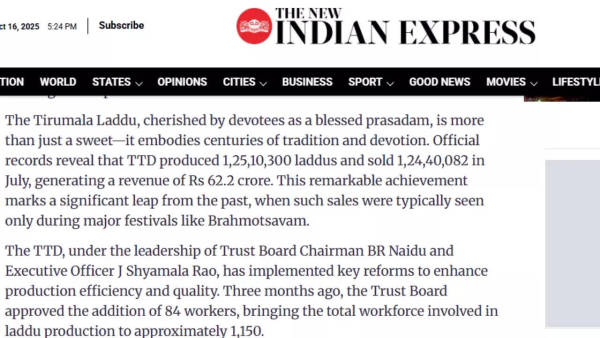
Perched on the seventh hill of the Seshachalam range, and with a never-ending stream of devotees, the Tirumala Venkateswara Temple in Andhra Pradesh is more than a pilgrimage spot. For decades the temple has attracted tens of millions of people every year, earned enormous donations that fund social schemes, and shaped how modern India manages mass pilgrimage. Here we will learn why Tirumala is frequently described as India’s most visited temple.
The shrine, dedicated to Lord Venkateswara (also called Srinivasa, Balaji or Govinda), sits on Venkatadri, one of seven hills that together give the town its name “Tirumala,” the holy hills. The temple is counted among the eight self-manifested (swayambhu) abodes of Vishnu. Pilgrims believe that Venkateswara grants blessings in the present age (
Kali Yuga). No wonder pilgrims flock to this temple, it’s a kind of urgent spiritual priority for many.
The temple’s daily
seva (service), large annual festivals such as Srivari Brahmotsavam, and time-tested offerings (notably the Tirupati
laddu prasadam) are all part of the pilgrimage tradition. The laddus themselves have been made in the temple kitchen for centuries.
The temple is managed by the Tirumala Tirupati Devasthanams (TTD), and has professionalised crowd management, online booking, and tiered
darshan (viewing) systems that make it possible for very large numbers of people to visit safely and predictably.

How many people visit Tirumala? As per a report in
Times of India, in 2024, TTD reported pilgrim footfall of roughly 2.55 crore devotees for the year, and
hundi (offerings) collections were reported at around INR 1,365 crore. This places Tirumala among the globe’s wealthiest and most-visited religious institutions. On peak days and festival seasons the daily footfall can swell dramatically.

The famed Tirupati laddu is not a boutique item. The temple kitchen produces hundreds of thousands of laddus daily and sells millions per month; in July 2025, as per a report in
The New Indian Express, TTD reported producing and selling over 1.25 crore laddus in that month alone. Laddus are both a devotional token and a significant revenue stream.
A typical visit involves either walking the pilgrimage path (Alipiri or Srivari Mettu) or driving/busing up to the temple complex; then, depending on the darshan ticket, a pilgrim may join a timed queue, participate in special seva (paid rituals), or attend free darshan slots. Expect thorough security, clear signage, and large queue complexes built to hold devotees safely. The sensory experience of incense, bells, the hum of recited mantras and the sight of gold-plated doors, is instantly recognisable to Hindus across regional lines.

Beyond Tirumala: other hugely visited Indian temples
Vaishno Devi: The cave shrine near Katra recorded about 94.83 lakh (9.48 million) pilgrims in 2024, one of the highest single-shrine totals in the country. The pilgrimage is managed professionally by the Shrine Board.
Kashi Vishwanath: The newly developed Kashi Vishwanath Dham and related infrastructure works have dramatically raised Varanasi’s daily and annual visitor numbers. Varanasi as a city now records tens of millions of visitors annually — a number that includes pilgrims to the Vishwanath complex.
Golden Temple: Sri Harmandir Sahib is the holiest Sikh shrine and also a massive tourist draw. Under normal circumstances the complex receives well over a lakh visitors a day (varies with seasons and geopolitical events), attracted by the ritual,
langar (community kitchen) and the unique architectural setting.
Sabarimala and Puri Jagannath: These shrines are seasonal juggernauts — Sabarimala records millions during its Mandala-Makaravilakku season, while Puri’s Rath Yatra annually concentrates huge crowds (often over a million during the festival window).
India’s mega-shrines are not just spiritual hubs; they are economic engines and social institutions. The donations collected at Tirumala underwrite hospitals, schools and charitable trusts; pilgrimage infrastructure creates employment and supports entire local economies.
 Perched on the seventh hill of the Seshachalam range, and with a never-ending stream of devotees, the Tirumala Venkateswara Temple in Andhra Pradesh is more than a pilgrimage spot. For decades the temple has attracted tens of millions of people every year, earned enormous donations that fund social schemes, and shaped how modern India manages mass pilgrimage. Here we will learn why Tirumala is frequently described as India’s most visited temple.
Perched on the seventh hill of the Seshachalam range, and with a never-ending stream of devotees, the Tirumala Venkateswara Temple in Andhra Pradesh is more than a pilgrimage spot. For decades the temple has attracted tens of millions of people every year, earned enormous donations that fund social schemes, and shaped how modern India manages mass pilgrimage. Here we will learn why Tirumala is frequently described as India’s most visited temple.

 The famed Tirupati laddu is not a boutique item. The temple kitchen produces hundreds of thousands of laddus daily and sells millions per month; in July 2025, as per a report in
The New Indian Express, TTD reported producing and selling over 1.25 crore laddus in that month alone. Laddus are both a devotional token and a significant revenue stream.
The famed Tirupati laddu is not a boutique item. The temple kitchen produces hundreds of thousands of laddus daily and sells millions per month; in July 2025, as per a report in
The New Indian Express, TTD reported producing and selling over 1.25 crore laddus in that month alone. Laddus are both a devotional token and a significant revenue stream.
